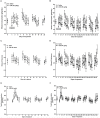LSD Administered as a Single Dose Reduces Alcohol Consumption in C57BL/6J Mice
- PMID: 30233372
- PMCID: PMC6127266
- DOI: 10.3389/fphar.2018.00994
LSD Administered as a Single Dose Reduces Alcohol Consumption in C57BL/6J Mice
Abstract
There is a substantive clinical literature on classical hallucinogens, most commonly lysergic acid diethylamide (LSD) for the treatment of alcohol use disorder. However, there has been no published research on the effect of LSD on alcohol consumption in animals. This study evaluated the effect of LSD in mice using a two-bottle choice alcohol drinking paradigm. Adult male C57BL/6J mice were exposed to ethanol to develop preference and divided into three groups of equal ethanol consumption, and then treated with single intraperitoneal injection of saline or 25 or 50 μg/kg LSD and offered water and 20% ethanol. The respective LSD-treated groups were compared to the control group utilizing a multilevel model for repeated measures. In mice treated with 50 μg/kg LSD ethanol consumption was reduced relative to controls (p = 0.0035), as was ethanol preference (p = 0.0024), with a group mean reduction of ethanol consumption of 17.9% sustained over an interval of 46 days following LSD administration. No significant effects on ethanol consumption or preference were observed in mice treated with 25 μg/kg LSD. Neither total fluid intake nor locomotor activity in the LSD-treated groups differed significantly from controls. These results suggest that classical hallucinogens in the animal model merit further study as a potential approach to the identification of targets for drug discovery and investigation of the neurobiology of addiction.
Keywords: alcohol; hallucinogen; lysergic acid diethylamide; mouse; psychedelic; serotonin receptor agonists; substance-related and addictive disorders.
Figures


References
LinkOut - more resources
Full Text Sources
Other Literature Sources

